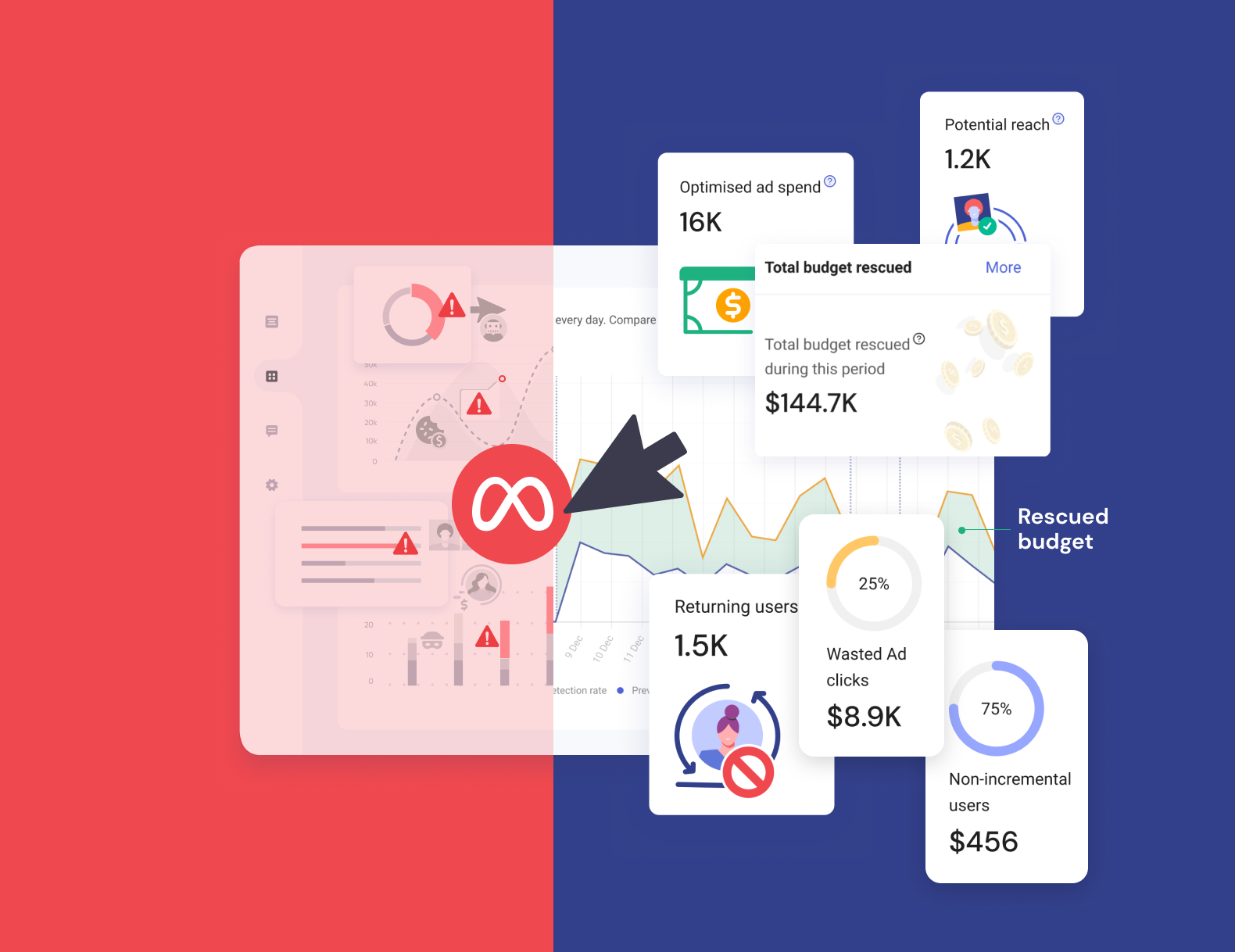Invalid Traffic: What You Need To Know

If you’re in charge of your business’ PPC or Google Ads campaigns, chances are you’ve come across the term “invalid traffic”, or “IVT”. But do you know the specific types of IVT there are? Or how they’re affecting your business? Invalid traffic includes any clicks or impressions that artificially inflate the costs for advertisers or the earnings for publishers. The experts at TrafficGuard have curated the IVT FAQ, your go-to guide for all things invalid traffic.
What is invalid traffic?
Invalid traffic - or IVT - refers to any clicks or impressions that may artificially inflate an advertiser’s costs. A significant component of IVT is non-human traffic, which includes bots and automated scripts that affect ad performance and website analytics. IVT is generated by actions that provide no legitimate value to the advertiser and covers both fraudulent activities as well as accidental clicks - in essence, any activity that doesn’t come from a real user with genuine interest is invalid.
What are the different types of invalid traffic?
All forms of IVT can be segmented into two categories, general invalid traffic and sophisticated invalid traffic. Unintentional invalid traffic, which can result from non-malicious activities, is a subset of general invalid traffic. While some IVT is more benign than others, both types of traffic can have a negative impact on ad spend and wider marketing campaigns.
General Invalid Traffic (GIVT)
GIVT is the form of invalid traffic most easiest to detect. It’s usually caused by web crawlers as they index web pages and is not done with malicious intent - it can come from accidental clicks and internal traffic.
- Known data-centre traffic: Impressions originate from data centres instead of actual users.
- Bots and spiders or other crawlers: Traffic is generated by automated programs, not humans. This bot traffic is a significant contributor to invalid traffic and ad fraud, inflating ad costs without yielding genuine conversions.
- Activity-based filtration: Impressions are identified through analysing user activity patterns that suggest non-human interaction.
- Non-browser user-agent headers or other forms of unknown browsers: Traffic originating from devices or programs that don’t identify themselves as standard web browsers.
- Pre-fetch or browser pre-rendered traffic: Impressions are generated before the actual content is loaded on the user’s screen.
Source: Page 5, Invalid Traffic Detection and Filtration Standards Addendum, Media Rating Council, June 2020
Sophisticated Invalid Traffic (SIVT)
SIVT is actively fraudulent traffic created to drain ad spend and create inaccurate data. SIVT is generally more difficult to detect than GIVT.
- Automated browsing: Browsing activity from devices or software that are not controlled by humans, such as bots, emulators, and custom automation tools.
- Incentivized human invalid activity: Invalid activity is generated by humans who are incentivized to do so, such as clicking on ads or visiting websites for money or rewards.
- Manipulated activity: Activity that is manipulated to appear as valid traffic, such as forced clicks, fake conversions, and hijacked measurement events.
- Falsified measurement events: Measurement events, such as clicks, impressions, and conversions, that are fake or invalid.
- Domain and App misrepresentation: Misrepresenting the source of traffic, such as spoofing the domain or app ID of a website or app.
- Advanced Bots and Crawlers: Bots and crawlers that are sophisticated enough to evade detection as invalid traffic.
- Hijacked ad elements (ads only): Ads that have been hijacked by malicious actors to serve invalid traffic.
- Deceptive ad serving (ads only): Techniques used to deceive users into clicking on ads or interacting with them in other ways.
- Invalid proxy traffic: Traffic that originates from invalid proxy servers.
- Adware and Malware: Malicious software that can generate invalid traffic.
- Incentivized manipulation of measurement: Offering incentives to people to manipulate measurement data, such as by clicking on ads or visiting websites.
- Misappropriated content: Using pirated or stolen content to generate invalid traffic.
- Cookie manipulation: Tampering with cookies to manipulate user data or generate invalid traffic.
- Differentiating valid and IVT from similar sources: The challenge of distinguishing between valid and invalid traffic that originates from the same or similar sources.
Source: Page 6-7, Invalid Traffic Detection and Filtration Standards Addendum, Media Rating Council, June 2020
How to detect invalid traffic?
- Monitor unusual spikes in click-through rates
- Look for high bounce rates and low-time on-site
- Analyse traffic patterns from different geolocations
- Use analytics tools to identify suspicious IP addresses
- Utilize Google Analytics to identify and filter out invalid traffic by tracking suspicious user behavior and blocking unwanted referrals
How can invalid traffic affect your business?
Wasted opportunity cost is an obvious consequence of IVT - marketers don’t want to spend their precious ad budgets on clicks unlikely to convert. However, IVT can affect more than just the financial side of the business. Here are some other significant impacts:
Wasted Media Spend
As we mentioned, the cost of large amounts of IVT can be very detrimental to campaign ROI. A customer of ours recently found that 28% of their ad spend was going towards invalidated clicks, amounting to a massive $65K wasted budget.
The ad traffic quality team plays a crucial role in detecting and filtering out invalid traffic, ensuring that advertisers do not pay for fraudulent clicks.
Compromised Campaign Data
Without complete certainty in the validity of traffic, marketers may struggle to make efficient campaign optimisation decisions, and any changes they do make that are influenced by IVT could be detrimental to campaign success. In the world of digital marketing, data is gold—so the cleaner and more accurate you can make your data, the better your campaigns will be. Intrusive ad implementations can lead to accidental clicks and invalid traffic, inflating ad metrics and causing significant revenue loss for publishers.
Misplaced Resource Investment
As well as compromising campaign efficacy, large volumes of IVT can cause marketers to direct spend to traffic sources which appear lucrative but are in fact producing non-opportunities. Precious time, effort, and budget are at risk of being funnelled into sources which do not produce a strong ROI.
To mitigate these risks, it is crucial to block invalid traffic and take proactive measures to maintain campaign integrity.
How can you stop invalid traffic?
Use an Ad Fraud Prevention Solution
TrafficGuard’s PPC Protection solution proactively stops your ads from showing to sources of IVT, and offers unprecedented levels of visibility across all your traffic:
- Identification and mitigation: The platform proactively stops your ads from showing to sources of IVT
- Enhanced visibility: Visibility across all your traffic, enabling you to get the most from your data
- Refund claims: When IVT cannot be stopped without catching genuine traffic in the crossfire, you can even use TrafficGuard reporting to submit a Google Ads refund claim
Understand Your Ad Traffic
Knowledge is power - by verifying every click-through, TrafficGuard will improve campaign quality, and ROI:
- Monitor valid traffic. Use TrafficGuard to monitor what you consider to be valid traffic, paying close attention to geography, pages visited and user behaviour
- Detect anomalies. Early detection will highlight issues such as unusual click patterns, high bounce rates, and traffic coming from suspicious sources - all of which could be a sign you have an IVT problem
- Inform marketing campaigns. A deeper understanding of your ad traffic will better inform your marketing campaigns. Use these quantifiable insights into your visitors’ habits and demographics to create more targeted and personalised campaigns
Steps to effectively manage invalid traffic:
- Implement an ad fraud prevention solution
Ad fraud prevention solutions like TrafficGuard are designed to proactively detect, prevent, and mitigate fraudulent activities online, ensuring your ad campaigns reach real users and generate genuine engagement. - Regular traffic audits
Regularly assessing your traffic sources will give you peace of mind that your campaigns are fraud-free - and if they’re not, audits will provide early warning of any red flags - Analyse patterns
Unusual activity to look out for includes sudden spikes in traffic, or regular patterns of abnormal behaviour in your campaigns, that could be a sign of fraud - Report and recover
By blocking sources of invalid and fraudulent traffic from interacting with your ads, you’ll enjoy cleaner traffic and better marketing outcomes.
FAQ
Q: How can I tell if the "unusual spikes" in traffic are actually IVT, and not just a successful campaign?
Here are some clues that it might be IVT and not genuine interest:
- High bounce rate coupled with low time-on-site: If visitors arrive but immediately leave, it suggests they're not genuinely engaged with your content.
- Suspicious geographic locations: A sudden influx of traffic from unusual or unexpected regions could be a red flag.
- Lack of conversions: If traffic spikes aren't translating into meaningful actions like sign-ups or purchases, it may indicate IVT.
- Unusual traffic sources: Check your analytics to see where the traffic is coming from. If it's from unfamiliar or low-quality websites, it could be a sign of IVT.
Q: You mentioned Google Ads refund claims. How do those work in practice?
Google does offer refunds for invalid clicks in some cases. Here's a simplified breakdown:
- Detection: Google's systems constantly monitor for IVT, but you can also use tools like TrafficGuard to provide more detailed evidence.
- Reporting: If you suspect significant IVT, you can gather data (using TrafficGuard's reporting features, for example) and submit a refund claim to Google Ads.
- Investigation: Google will review your claim and investigate the traffic in question.
- Refund: If Google confirms the presence of IVT, they may issue a credit for the cost of those invalid clicks.
Q: Besides using a tool like TrafficGuard, what are some proactive steps I can take to minimise IVT?
While a dedicated solution is highly recommended, here are some additional measures you can take:
- Regularly review your Google Analytics data: Look for suspicious patterns in user behaviour, traffic sources, and demographics.
- Implement robust website security: Strong security measures can help prevent bots and malicious actors from accessing your site.
- Be cautious with ad placements: Avoid partnering with websites or networks known for having high IVT rates.
- Stay informed: Keep up-to-date on the latest IVT trends and best practices to stay ahead of fraudsters.
Additional Resources:
- TrafficGuard's whitepaper on the true cost of ad fraud
- What happens when invalid traffic meets TrafficGuard?
- What Types of Invalid Traffic Does TrafficGuard Prevent?
Get started - it's free
You can set up a TrafficGuard account in minutes, so we’ll be protecting your campaigns before you can say ‘sky-high ROI’.
Subscribe
Subscribe now to get all the latest news and insights on digital advertising, machine learning and ad fraud.








